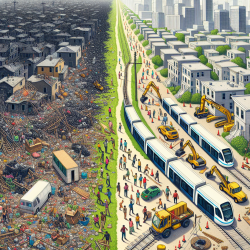Understanding the Impact of Transit Developments on Community Health
As practitioners dedicated to improving children's outcomes, understanding the broader socio-economic factors that influence health is crucial. Recent research, as outlined in "The Color of Health: Residential Segregation, Light Rail Transit Developments, and Gentrification in the United States," provides valuable insights into how urban planning and transit developments can impact community health.
The Intersection of Transit Developments and Health
The study highlights that transit-oriented developments (TODs), while beneficial in promoting accessibility and reducing traffic congestion, can inadvertently lead to gentrification. This process often displaces low-income residents and communities of color, exacerbating existing health disparities. The research underscores the importance of considering social determinants of health when planning urban transit projects.
Key Findings and Implications for Practitioners
- Residential Segregation: Historical and ongoing segregation practices have significant health implications. Practitioners should be aware of how these patterns affect access to healthcare and other essential services.
- Gentrification and Displacement: Transit-induced gentrification can lead to displacement, which is linked to adverse health outcomes such as increased stress, mental health issues, and chronic diseases.
- Health Outcomes: The study indicates that displaced populations often experience worse health outcomes, including higher rates of chronic diseases and mental health disorders.
Strategies for Mitigating Negative Impacts
Practitioners can play a role in advocating for policies that mitigate the negative impacts of TODs. This includes supporting affordable housing initiatives, engaging in community planning, and advocating for equitable distribution of resources.
Local governments and planners can implement strategies such as inclusionary zoning and property tax relief programs to ensure that TODs benefit all residents, particularly those from marginalized communities.
Encouraging Further Research
While this research provides a comprehensive overview of the issues, further studies are needed to explore the long-term health impacts of transit-induced gentrification. Practitioners are encouraged to engage with local communities and policymakers to advocate for research that addresses these critical issues.
To read the original research paper, please follow this link: The Color of Health: Residential Segregation, Light Rail Transit Developments, and Gentrification in the United States.










